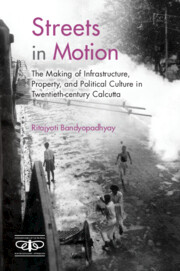 Streets in Motion
Streets in Motion Published online by Cambridge University Press: 30 June 2022
The ground, in the words of one planner, is ‘the traffic-flow-support-nexus for the vertical whole’. Translated, this means that the public space has become a derivative of movement. The idea of space as derivative from motion parallels exactly the relations of space to motion produced by the private automobile…. Today, we experience an ease of motion unknown to any prior urban civilization … we take unrestricted motion of the individual to be an absolute right. The private motorcar is the logical instrument for exercising that right, and the effect on public space, especially the space of the urban street, is that the space becomes meaningless or even maddening unless it can be subordinated to free movement…. The city street acquires, then, a peculiar function—to permit motion….
—Richard SennettWe attain to dwelling, so it seems, only by means of building. The latter, building, has the former, dwelling, as its goal.
—Martin HeideggerAutomobility began to emerge as a significant aspect of urban mobility in the west as well as in prime colonial cities such as Calcutta and Bombay in the last decade of the nineteenth century. Automobiles became ubiquitous and dominant in many of these cities by the 1940s. In South Asian cities such as Calcutta, automobiles had to share space and time with other, more primordial and slower, means of human locomotion throughout the twentieth century (and even the twenty-first), producing differential mobilities on city roads. Their emergence necessitated and culminated in several significant urban spatial reforms, which began—as we have seen—as a counterinsurgency and public health measure in the mid-nineteenth century. Automobility gave these reforms a new orientation by which—as Richard Sennett mentions in the opening quote—public space turned out to be ‘a derivative from motion’.
The streets that literally undergirded and made possible the modern automobile age came into existence in prime cities all over the world in the first half of the twentieth century. A set of new paving experiments facilitated and coincided with a host of other innovations, such as sidewalks, public squares, parks, and elevated tramways on green boulevards. These spaces materialized in the triadic encounters of engineers, commoners, and agitators. In giving shape to streets, both experts, who planned their construction, and users, who navigated their lives through them, ended up shaping each other in myriad ways.
To save this book to your Kindle, first ensure [email protected] is added to your Approved Personal Document E-mail List under your Personal Document Settings on the Manage Your Content and Devices page of your Amazon account. Then enter the ‘name’ part of your Kindle email address below. Find out more about saving to your Kindle.
Note you can select to save to either the @free.kindle.com or @kindle.com variations. ‘@free.kindle.com’ emails are free but can only be saved to your device when it is connected to wi-fi. ‘@kindle.com’ emails can be delivered even when you are not connected to wi-fi, but note that service fees apply.
Find out more about the Kindle Personal Document Service.
To save content items to your account, please confirm that you agree to abide by our usage policies. If this is the first time you use this feature, you will be asked to authorise Cambridge Core to connect with your account. Find out more about saving content to Dropbox.
To save content items to your account, please confirm that you agree to abide by our usage policies. If this is the first time you use this feature, you will be asked to authorise Cambridge Core to connect with your account. Find out more about saving content to Google Drive.